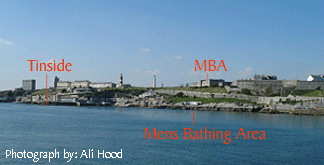
50 21.81N
04 08.72W
50 21.74N
04 08.85W
| Hoe Foreshore | ||
| Lat/long |  |
|
| 50 21.74N 50 21.81N |
04 07.96W 04 08.72W |
|
| 50 21.71N 50 21.74N |
04 08.00W 04 08.85W |
|
| Location description (1957) | |
| The northern shore of the Sound, between Batten R.A.F. Station and Cremyll, contrasts sharply with that of other shores in consisting of a pure hard limestone (remains of a palaeozoic coral reef) of the Middle Devonian period. A narrow belt of this limestone, planed to a maximum of 110 ft. O.D., runs east-west from Billacombe through Oreston, Cattedown, the Hoe, and Devil's Point, to Cremyll, and is widely breached by both the main rivers and by the branch creeks of Hooe Lake, Sutton Pool, Millbay, and Stonehouse Lake. Where the shore survives in an original condition there is usually a low cliff of white limestone, stained brown in the tidal zone, very irregularly eaten into by the sea, but normally forming a steep slope to below low-water mark. Here and there are deep fissures and caves. Erosion seems to proceed throughout the tidal zone by the formation of surface pits and pockets, some of which grow into pot-holes and eventually are broken into from below. Rock pools are often formed in pockets in the rock, particularly in the upper part of the shore. In the small bays these are collections of beach material in the lowwater region consisting chiefly of rounded limestone stones and gravel, with which (as at Tinside) artificially introduced materials may be mixed. In spite of the urbanization of much of this foreshore, sufficient of the natural features survive to support much of the characteristic fauna and flora. The upper and middle levels bear a dense barnacle population, amongst which Chthamalus stellatus dominates. The empty barnacle shells and the abundant small pits and fissures harbour a population of gastropod molluscs including Otina ovata, Leucophytia bidentata, Littorina neritoides, and abundant young L. saxatilis. The two former are now less readily found than at one time. Associated fauna includes the collembolan Anurida maritima, the isopod Campecopea hirsuta, and the bivalve Lasaea rubra. In the middle shore Balanus balanoides occurs with a frequency that has varied through the years, this barnacle and the recent introduction Elminius modestus harbouring the parasitic isopod Nemioniscus balani. The numerous rock-pools are coated with growths of coralline and tufted algae; those near high water are subject to fluctuating conditions and harbour specially tolerant species such as the copepod Tigriopus fulvus which often swarms. In some of these pools the small archiannelid Dinophilus taeniatus is numerous in the spring; some of them, again, are favourable for the hydroid Coryne pusilla and larvae of the midge Cricotopus fucicola. In the low-water region the rocks and loose stones are everywhere bored by the bivalve Hiatella striata (Saxicava). Other limestone borers are common, including species mentioned below in the fauna of the Breakwater. Empty Hiatella burrows provide lodging space for worms such as Lepidonotus clava, crustaceans such as Dynamene bidentata, and various small molluscs. On the whole the fauna under loose stones and other cover is similar to that found on the shores of shale rock. such as Rum Bay. In a small cave near the Men's Bathing-place, shaded from direct sun, and never exposed to the air for long, the walls are normally freely coated with sponges such as Sycon ciliatum, Grantia compressa, and Leucoselenia variabilis. Tubularia indivisa also settles here on occasions. |
| Updated information | Description updated in 1999 |
| Species List | >Alcyonium digitatum |